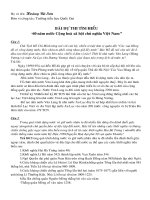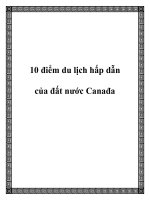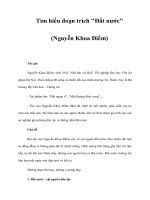Tìm hiểu đất nước Canada
Bạn đang xem bản rút gọn của tài liệu. Xem và tải ngay bản đầy đủ của tài liệu tại đây (8.14 MB, 69 trang )
HANOI OPEN UNIVERSITY
FACULTY OF TOURISM
CANAD
A
Lecturer: Trần Thị Nguyệt Quế
Group 9: Canada
Student name: Hoàng Thị Yến Kiều –
Leader
Lê Thị Thảo
Lê Minh Giang
Nguyễn Lưu Mỹ Hạnh
I.
Introduction
I. 1
Assignment
The country we research in the subject of tourist psychology and effective
communication in tourism is the second largest country in the world - Canada.
This can be seen as the largest study of four members during the past two years.
At the beginning of our work, we encountered some difficulties in getting ideas,
difficulties in finding information, foreign language and division of tasks. But
above all, we have learned and apprehended many things well, not only the
knowledge of the beautiful country and the civilized people here, but also the
skills in teamwork, research skills study, survey, communication skills ...
This report is the result of the hard work of the past two months of all members
in group 9. We are quite satisfied with it. Knowledge is endless, There will be
some information that we can not mention and some shortcomings in the
presentation of information. Therefore, we hope to receive feedback from you so
that we can improve and perfect our knowledge and skills in this course as well
as the upcoming subjects.
This final research on Canada is mainly focussed on “culture” as Canadians
traditionally define it, which is to say, the collection of things that provides a
sense of purpose and patriotism to residents of the country, including both
cultural products and social attitudes. Besides, we are going to look at national
tourism potential of Canada and tips for serving Canadians effectively.
So “What does it mean to be Canadian?” The answer is all of the below.
2
I. 2
Group
Student’s name
Work
Mark
- Assignment of duties.
Research
about
“Nationality
Hoàng Thị Yến Kiều - characteristic”, “Culture (costumes, table
Leader
manners, the maple leaf)”, “Tips for serving
market effectively”.
- Power point and word.
Lê Thị Thảo
- Research about “Overview”, “List of
hotel”.
- Power point and word.
Lê Minh Giang
- Research about “Tourism potential”,
“Interview results”.
- Power point and word.
Nguyễn Lưu Mỹ Hạnh
- Research about “Culture (Cuisines, taboos,
festivals, religions, funeral customs,
communication principles, traditions and
customs)”, design a tour.
- Power point and word
3
I. 3 Country
Canada - The globe's second-biggest country has an endless variety of landscapes.
Sky-high mountains, glinting glaciers, spectral rainforests and remote beaches are all
here, spread across six times zones, modern Canada is a spectrum of cultures, and an
ethnic mosaic of immigrant groups, as well as the native peoples
In a country which means ‘village’, where the population speak many languages and
come from many places, where macaroni and cheese are consumed more than
anywhere else in the world and where locals can ice skate on the ocean in winter Canada truly is a colourful place.
4
II.
Body
II.1 Overview
II.1. 1
The basic information
Area: 9.984.670 (sq km)
Population: 35,546,000 (2017 est.)
Mode: Constitutional Monarch
Capital: Ottawa, Ontario Province
Province most: Québec
Primary language: English and French
Currency: Canadian Dollar (CAD)
II.1. 2
Location
Located in North America.
The second largest country in the world, after Russia.
Stretches from the Atlantic Ocean in the East to the Pacific Ocean in the West, and
borders the Arctic Ocean in the north.
Northwestern borders Alaska with the United States
5
II.1. 3
History
The first inhabitants of Canada believed to have come from Asia thousands of years
ago.
In the early 1960s, French and British residents began to settle permanently in Canada.
Officially became a nation on July 1, 1867.
The four provinces are Ontario, Quebec, Nova Scotia and New Brunswick.
The first prime minister was John A. Macdonald.
Today, Canada has 10 provinces and three territories .
National Day: 1st July.
Memorial Day of the Battle Soldiers: 11th November.
Meaning of country name:
Made from "Kanata".
Indian origin, meaning 'village'.
Not only refers to a specific village but also to Donnacona, in present-day Quebec.
6
The national meaning of Canada:
Selected in 1965.
White color around: Snow white and the harsh climate of winter.
Red 2 sides: Representing the Atlantic and Pacific.
Maple leaf: Symbol of Canada.
II.1. 4
Politics
A constitutional monarchy.
Queen Elizabeth II is the Queen of Canada and head of state.
Authorized representative is the Governor of Canada.
The Canadian legislature is in Congress with two houses: the Senate and the House
The Senate includes the appointed Senators.
The House of Representatives is composed of Representatives (one for each
constituency) who are free to vote.
Currently has two legal systems: the British Common Law System and the civil law
system which applies the province of Quebec.
7
II.2 Tourism potential
II.2. 1
Cultural tourism potential
CN Tower: Canada’s most recognizable and celebrated icon
Toronto’s tallest and most defining landmark (553.33m ).
Guinness World Records for Highest Wine Cellar ( 351m ).
Highest External Walk on a Building (2011).
The world’s highest full-circle, hands-free walk.
One of the seven Wonders of the Modern World.
8
Old Québec: The cradle of French civilization in North America.
Designated a World Heritage treasure by UNESCO (1985).
Founded in 1608, mix of architecture, heritage, art, and culture.
8.2 million inhabitants , 95% of them French-speaking.
Uniquely European flavour, winding streets, museums, churches, monasteries,
palaces.
9
National Gallery of Canada: One of the greatest art institutions in the world.
Created in 1880
Display paintings, sculpture, and decorative arts from the 14th to 20th century
Displays of contemporary art change every three to six months
Its most famous works of art – Maman – a spider carrying a sack of 26 pure white
marble eggs under her belly.
10
II.2. 2
National tourism potential
Abraham Lake: Stunning Bubbles Frozen Under Lake Abraham.
Artificial lake, created in 1972.
Surface area of 53.7 km2, length of 32 km.
Time to travel : Spring, winter.
Don't leave without: Getting a few snapshots.
11
Bay of Fundy: The natural wonder of our world
The highest tides in the world (21 m).
Between provinces of New Brunswick and Nova Scotia.
The bay covers some 9,300 square km.
It extends 151 km, 52 km wide at its entrance.
The rarest whales in the world, semi-precious minerals, dinosaur fossils.
12
Auyuittuq National Park: The land that never thaws.
Canada's first national park located north of the Arctic Circle.
Set up as a national park reserve in 1976.
Vegetation is sparse, land-based wildlife is not abundant, the coast is home for millions
of seabirds.
85% of the area is ice, rock and mountain.
13
II.3
Nationality characteristics
Informality
Casual in dress and language:
No strict dress codes in the workplace (unless you work in a bank or law office).
Don’t flash expensive shoes, accessories, etc.
Clothes are informal to casual.
First-name basis is the norm even seniors or superiors.
Address them by Mr./Mrs./Ms or Dr at first meeting.
First-name basis is the norm.
Order and space
Keep away from discussions of salary, family life, weight, religion and other personal
topics.
Ask permission before using anything that is not yours.
Disruptive behavior: cutting in line, speaking out of turn, shouting, talking loudly…
Inviting guests over isn’t that common either.
Have a meeting in a public place like a restaurant or a coffee shop.
Decorum is part of keeping order and respecting other people’s space.
Individualistic yet community-oriented
Contributing to the betterment of the community is a priority.
Get involved by volunteering, donating, and by generally maintaining pride and
affinity for their community.
Highly aware of their responsibility to the community.
Punctuality
14
Punctuality is a sign of respect.
Arrive on time or at least 5-10 minutes earlier.
Deadlines are taken seriously.
Telephoning people in the very early morning or very late night = rude and disruptive.
Punctuality is a sign of respect.
Respect
Apologizes despite not being at fault.
90% of Canadians aged 18-25 will immediately apologize if a stranger bumps into
them.
Manifests through politeness, punctuality, tolerance and social order.
Talk about a person’s looks, beliefs, age, gender and status = Harassment.
Openly disagree, but tactfully.
Clear and direct, not to “beat around the bush” and speak up for yourself.
Agreeable
Complain usually about the weather.
Few occured argument.
Satisfied with lives
(Higher level of life satisfaction than Americans, scoring 7.4 out of 10, versus 7.0 in
the U.S).
15
Regionalism
Have an affinity to their province or region, sometimes more than their country.
Generalizations:
Atlantic provinces (the Maritimes and Newfoundland and Labrador) are somewhat
reserved and old-fashioned.
Ontario is business-like and conservative.
Western Canada (Alberta, Manitoba and Saskatchewan) are open and friendly.
British Columbia is unconventional and progressive.
Quebec is distinct and autonomous.
The North (Yukon, the Northern Territories and Nunavut) has a strong pioneer spirit.
Love for the environment
Appreciate nature and revel in camping.
Maintain their parks and open spaces.
Adopt and follow environment-friendly policies.
Strong pride in their rich and bountiful resources.
Have deep-seated respect for the environment
Early meal and snack throughout the day
Have a meeting with dinner between 5 p.m to 6 p.m.
Start eating lunch before noon and to be done with supper long before 7 p.m.
Tend to snack.
Have a snack before going to bed ( sleep late)
16
17
II.4
II.4.1
Culture
The maple leaf
A symbol of Canada.
Symbolizes strength, nature, culture, ethnicity and history:
Discovered the food properties of maple sap (1700).
Help to beautify the landscape.
Contribute valuable wood products.
Viewed as a tree that rewards labour and perseverance.
Evokes the history of early Canadians able to “tame” the wilderness for their own
benefit.
Shapes instantly recognizable and easy to remember.
Show an unassuming, neutral symbol that posed no threat to his or her identity or
interests.
Symbol of strength and endurance
Is simply easier to draw.
Red colour, one of Canada’s national colours (the other is white).
Acer - scientific name for the Maple tree, comes from Latin ǎcěr which means “sharp”,
making reference to the sharpen tips of its leaves.
18
19
II.4.2
Cuisines
Three standard meals a day includes breakfast, lunch and dinner.
Breakfast:
-
Skipped or half-hearted meal because morning tend to be rushed.
-
Usually
eggs,
fried
pork sausages or bacon,
fried
or
deep-fried potatoes,
toasted bread, pancakes (or French Toast) and syrup, cereals, or hot oatmeal.
-
For those in a rush, may only consist one of above.
20
21
Lunch:
-
Often a light meal.
-
Tend to be portable or easy to make, such as sandwiches, soups, or salads.
-
On occasions when more time and effort is available, can be large as dinner.
Dinner:
-
Almost always the largest and most well-prepared meal.
-
Usually feature a large meat entrée( chicken breast, steak, pork chop, hamburger, or
ground beef) with cooked vegetables( carrots, peas, green beans, cauliflower, broccoli,
or corn), and a grain or starch-based “side” (rice, pasta, potatoes, or bread).
22
Meat plays a key role in all three formal meals, especially dinner should have some
special and large meat portion.
Famous food:
Poutine:
-
Consists of french fries and cheese curds topped with light-brown gravy.
-
Originated in Quebec in the 1950s.
-
The best spot to get poutine is in Montreal.
23
Beavertails:
-
A thick piece of deep-fried dough, shaped to resemble real beaver tails and are often
topped with chocolate, candy, and fruit.
-
A famous trademarked treat made by a Canadian-based chain of pastry stands.
-
Gained White House recognition during U.S. President Barack Obama's 2009 trip to
Ottawa.
24
Butter tarts:
-
Popular around the holidays and Christmas time.
-
Consist of butter, sugar, syrup and eggs filled into a pastry crust, often includes either
raisins or nuts.
25









